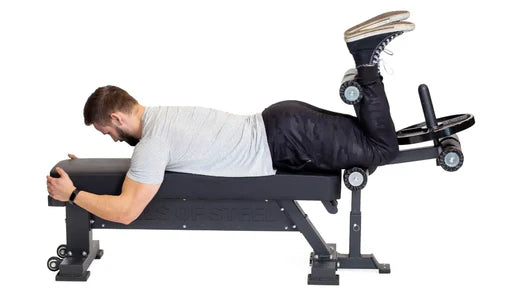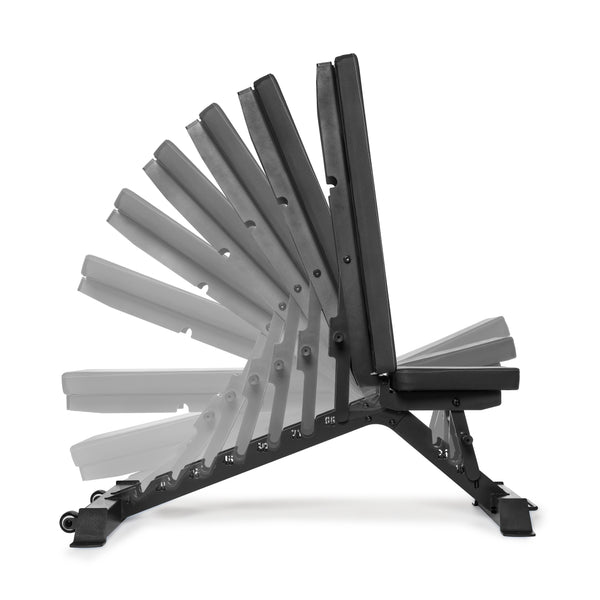When it comes to building powerhouse legs, home gym owners often ask: "Is leg curl the same as leg extension?"
While these two exercises might sound like they’re just different sides of the same coin, they actually target different muscle groups and offer unique benefits.
Let's dive into the nitty-gritty of leg curls and leg extensions, compare their pros and cons, and figure out how to fit them into your training routine.
Leg Curl vs. Leg Extension: The Basics
What is a Leg Curl?
A leg curl primarily targets your hamstrings. It involves flexing your lower leg behind you while keeping your thighs stationary. Think of it as a way to curl your legs, hence the name. This exercise can be performed either lying down on your stomach like you’re a teenage in the 80s spending 6 hours on the phone (prone leg curl) or sitting upright like… something else (seated leg curl).
What is a Leg Extension?
On the flip side, the leg extension focuses on your quadriceps. It requires you to extend your lower legs out from a seated position, straightening them until they are parallel to the floor. This movement isolates the quads, giving them a serious workout.
Leg Curl vs. Leg Extension: The Similarities
While these are two different exercises, there are a few overarching similarities that make them two sides of the same coin:
Same Machine, Different Setup
Both exercises are usually performed on the same piece of equipment. Most leg machines have settings for both leg curls and leg extensions, making them versatile for home gyms.
Isolation Exercises
Both are isolation movements, meaning they target specific muscle groups rather than working multiple muscles at once. This makes them great for focusing on particular areas.
Joint Movements
Both exercises involve the knee joint as the primary mover. However, the direction of the movement differs: flexion for curls and extension for extensions.
Leg Curl vs. Extension: The Differences
Now onto the key differences between leg extensions and leg curls.
Muscles Worked
Leg Curls hit the hamstrings hard. These muscles run along the back of your thighs and are crucial for activities like running and jumping.
Leg Extensions zero in on the quadriceps, the muscles on the front of your thighs. These are key for activities that require straightening your legs, like kicking a ball.
Movement Direction
The leg curl involves bending your knees and bringing your heels towards your buttocks. Conversely, the leg extension involves straightening your knees and lifting your lower legs.
Pros and Cons of Leg Curls
Like all exercises, there are upsides and downsides to performing them. Here are a few to consider before adding leg curls to your routine:
Leg Curl Pros
- Hamstring Isolation - Perfect for targeting those hard-to-reach hamstrings.
- Improves Flexibility - Great for improving the flexibility and strength of the hamstrings, which can help in preventing injuries.
- Balanced Strength - Helps balance out quad-dominant routines, ensuring your leg development is well-rounded.
Leg Curl Cons
- Knee Strain - Can place strain on the knees if not performed correctly or if too much weight is used.
- Limited Functionality - While great for building your bod, it’s not as functional as compound movements, like deadlifts, for building strength.
Leg Extension Pros and Cons
Leg extensions also have their ups and downs—particularly when you’re doing them! See what I did there? Ahem. Anyway. The pros and cons:
Leg Extension Pros
- Quad Focus - Ideal for isolating and building the quads.
- Knee Health - Strengthening the quads can support knee health and improve performance in activities that require knee extension.
- Rehabilitation - Often used in rehab settings to strengthen the quads after an injury (but only with professional oversight. Don’t go getting any ideas.)
Leg Extension Cons
- Knee Pressure - Can exert high levels of stress on the knee joint, potentially leading to injury if overdone. Don’t do these without talking to a medical professional if you have knee issues.
- Less Functional - Similar to leg curls, it’s less functional compared to compound exercises that mimic real-life movements. Unless you’re some sort of swingset champion, in that case, by all means.
Incorporating Leg Curls and Leg Extensions Into Your Training
To achieve well-rounded leg strength and size, it's crucial to include both leg curls and leg extensions in your workout regimen. Here's a simple way to integrate them:
- Warm-Up - Always start with a good warm-up to get your muscles ready. Dynamic stretches or light cardio work wonders.
- Leg Curls - Perform 3 sets of 10-12 reps. Focus on controlled movements, avoiding jerky motions to protect your knees.
- Leg Extensions - Follow up with 3 sets of 10-12 reps. Again, keep it controlled and focus on feeling the burn in your quads. These are great in a superset!
- Compound Movements - Include squats or lunges to ensure you're working all the muscles in your legs comprehensively. In most programs, you’ll do these primary movements first (hence the name) and use curls and extensions as an accessory movement.
- Cool Down - End with static stretching to improve flexibility and reduce muscle soreness. You’re not 20 anymore, chum. Unless you are, in which case, get outta here!
These are just guidelines. Talk to a trainer or make them work for your routine to reach your desired results.
Leg Curl vs. Leg Extension FAQs
Q: Can I Do Leg Curls and Leg Extensions on the Same Day?
A: Absolutely! They target different muscles, so incorporating both into the same workout is a great way to ensure balanced leg development.
Q: Are Leg Curls and Leg Extensions Safe for Beginners?
A: Yes, as long as you use proper form and start with a manageable weight, both exercises can be safely performed by beginners.
Q: Can I Do These Exercises Without a Machine?
A: Yes, you can use resistance bands for leg curls and leg extensions if you don't have access to a machine. While not as effective as the machine versions, they’re a good alternative for home workouts. You can also get bench attachments and rack attachments for these exercises. Oh look at that, we sell some. Weird.
The Verdict
Leg curls and leg extensions might share a machine and a penchant for making your legs burn, but they play distinct roles in your workout routine. By incorporating both exercises, you can ensure that your legs are as strong, balanced, and injury-resistant as possible.



